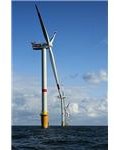History of Wind Mills
How do windmills generate electricity? Though Don Quixote attacked the windmill, it is no monster. It is an important invention which can help us to reduce our carbon footprint and save our earth from global warming. In various parts of the world and coastal areas, there is an abundance of breeze. These windmills, if installed, can generate large amounts of electricity to serve the needs of the local people.
Historically windmills have been used for the grinding of the grains into flour, for taking out water from wells, and for similar other applications. Wind energy has been used by man for a very long time. The earliest recorded practical windmills were said to be used in Sistan in Afghanistan around 7th to 8th century and was used for pumping water as well as grinding corn. In Europe windmills surfaced around the twelfth century. In Denmark where the sea breeze is abundant there were an estimated 2500 windmills around 1900. In fact Germans used wind turbines in WW II to recharge the batteries of their U boats.
Nowadays you see windmills in all places where breeze is abundant. In many countries they are a significant means of power generation. On the coasts of Gujarat in India you see a large number of windmills. Windmills have a simple working principle, need less maintenance, and last long as other means of power generation.
Wind energy has re-emerged as a significant source of energy in the minds of power engineers due to the following reasons:
- The need for new sources of energy as the fossil fuel reserves are declining.
- The potential is great as wind energy exists at many places all over the world, and at some places the density is very high, making the prospects attractive.
- With advances in technology, the highly efficient windmill airfoil design gives a high efficiency and can be profitably produced.
- The last and most important is the political will, which was lacking until now. With the media discussing the effects of global warming and the common man becoming aware of it, we are now worried for the future.
Types of Wind Mills
The modern windmill is more correctly called as a wind turbine as it can generate electrical power. (The older windmills in contrast generated mechanical power.) Wind turbines are primarily divided into horizontal axis windmills and vertical axis windmills. The horizontal axis wind turbines are of the following types:
- Single bladed
- Double bladed
- Three bladed
- US farm windmill multi-bladed
- Bicycle multiple bladed
- Upwind
- Downwind
- Sail wing
- Multi-rotor
- Counter rotating blades
- Cross wind savonius
- Cross wind paddles
- Diffuser
- Concentrator
- Unconfined vortex
- Savonius
- Multi-bladed savonius
- Plates
- Cupped
- Darrieus
- Giromill
- Turbine
- Magnus
- Airfoil
- Deflector
- Sunlight
- Venturi
- Confined vortex
Working Principle of Wind Mills
A wind turbine is a machine that coverts wind energy into electricity. The generators are connected to battery charging circuits and finally to large utility grids. In windmills the wind passes through the airfoil section of the blades and the lift produced generates a torque which is then transformed to electricity in the generator. It is basically the conversion of the wind energy into the mechanical energy of the turbine and then finally to electricity. As the output of the wind turbine is dependent on the availability of the winds it is intermittent and undependable. They can however be used along with conventional generators in a large grid and can reduce the loads of these generators when they are generating. The other option is to use storage devices like batteries and then discharge the electricity uniformly.
The main parts of the windmills are as follows:
- The rotors consisting of the blades and the hub.
- The drive train and gears along with the mechanical brakes. The brakes are used in the maintenance work and when a storm is coming.
- The generator which generates electricity.
- The yaw system which rotates the housing toward the direction of the wind.
- Tower and foundation.
- Battery and the electrical system to transmit to the grid.
By Sunita Sanguri
This blog talk about engineers topics, engineering courses and tutorials, engineering jobs: electrical engineering,mechanical engineering,nuclear engineering, petroleum engineering, biomedical engineering, biological engineering,aerospace engineering, industrial engineering, drilling engineering, offshore engineering, reservoir engineering.
adsense
Thursday, July 26, 2012
How Windmills Generate Electricity
Subscribe to:
Post Comments (Atom)

No comments:
Post a Comment